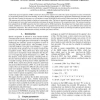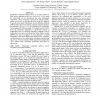346 search results - page 52 / 70 » Speaker recognition |
TSD
2004
Springer
14 years 1 months ago
2004
Springer
Tracheoesophageal (TE) speech is a possibility to restore the ability to speak after laryngectomy, i.e. the removal of the larynx. TE speech often shows low audibility and intellig...
ISCAS
1999
IEEE
14 years 27 days ago
1999
IEEE
An acoustic-phonetic feature- and knowledge-based system for the automatic segmentation, broad categorization and fine phoneme recognition of continuous speech is described. The s...
LREC
2010
13 years 10 months ago
2010
Audiovisual speech recognition (AVSR) systems have been proven superior over audio-only speech recognizers in noisy environments by incorporating features of the visual modality. ...
ICASSP
2009
IEEE
14 years 3 months ago
2009
IEEE
When exposed to environmental noise, speakers adjust their speech production to maintain intelligible communication. This phenomenon, called Lombard effect (LE), is known to consi...
ICASSP
2009
IEEE
14 years 3 months ago
2009
IEEE
Independent component analysis (ICA) is not only popular for blind source separation but also for unsupervised learning when the observations can be decomposed into some independe...


